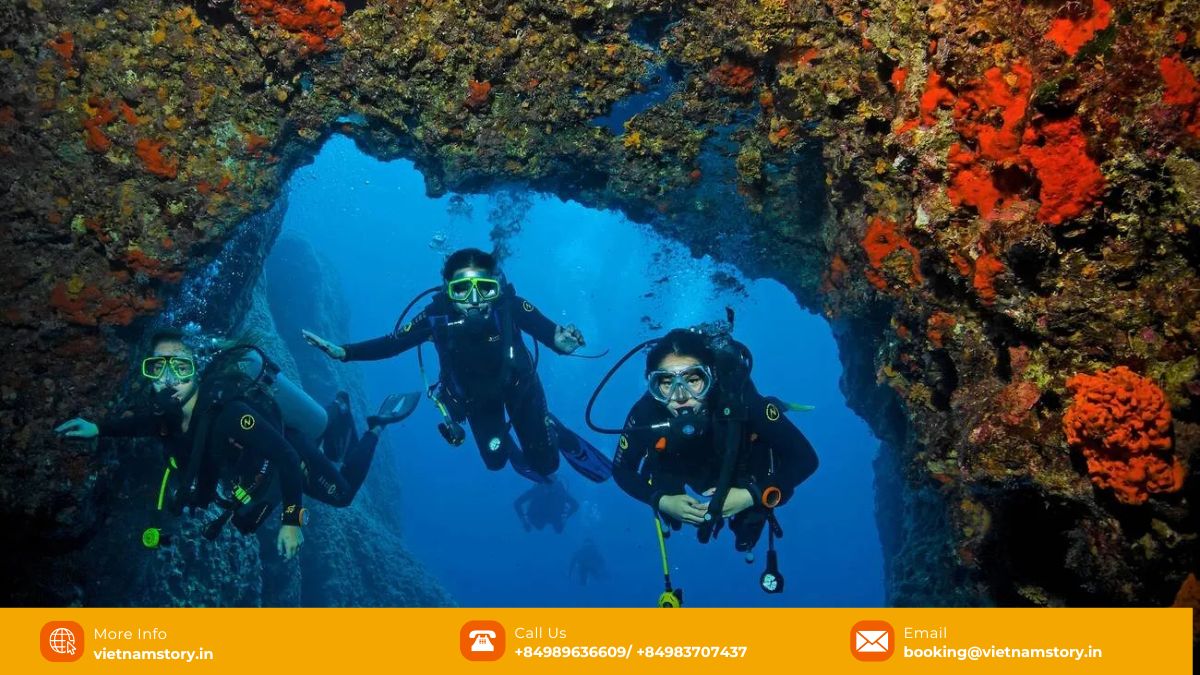Boasting a massive 3260 km coastline of stunning landscapes, white sandy beaches, and turquoise waters set against lush greenery, Vietnam is rapidly emerging as a paradise for scuba diving enthusiasts from India and around the globe. While perhaps less famous than some neighbours, scuba diving in Vietnam offers a unique and rewarding experience. The country’s waters hide a wealth of underwater treasures: vibrant coral reefs teeming with diverse marine life, intriguing wrecks, and dramatic underwater topography. From the popular hubs of Nha Trang and Phu Quoc to the pristine sanctuary of the Con Dao Islands, Vietnam presents affordable and unforgettable underwater adventures for divers of all levels. This guide delves into the best Vietnam dive sites, marine biodiversity, optimal diving conditions, essential equipment, costs, and certification opportunities like PADI and SSI.

The Rising Tide: Why Choose Scuba Diving in Vietnam?
Scuba diving in Vietnam presents a compelling combination of affordability, diverse dive sites, and a sense of undiscovered adventure. Its extensive coastline and numerous islands offer a less crowded alternative to more established diving destinations in Southeast Asia. This, coupled with significantly lower prices compared to many other regions, makes Vietnam particularly attractive for budget-conscious travelers, including those visiting from India. The country caters to all skill levels, with dive sites ranging from beginner-friendly shallow coral gardens to challenging walls, caves (like the famous Moray Cave), and wrecks. Furthermore, there’s a growing focus on marine conservation and responsible diving practices across popular locations.
Exploring the Best Locations for Scuba Diving in Vietnam
Vietnam’s diverse coastline offers a variety of underwater environments (root attribute: Environment – Underwater/Marine) and experiences (root attribute: Purpose – Exploration/Adventure), each with unique characteristics and attractions. Choosing the right location (root attribute: Location-Specific) depends on your experience level (root attribute: Skill Requirement) and what you hope to see.
Nha Trang (Khanh Hoa province): The Vibrant Heart of Vietnamese Diving
Nha Trang is considered the most established diving hub in Vietnam, boasting a well-developed infrastructure and a wide variety of easily accessible dive sites.
Hon Mun Marine Protected Area: A Biodiversity Hotspot
Just a short boat ride from Nha Trang lies the Hon Mun Marine Protected Area, a key entity and the epicentre of the region’s diving scene. This underwater paradise offers numerous dive sites, including:
- Madonna Rock: Famous for its incredible underwater architecture, featuring swim-throughs, tunnels, and caveswhere divers might spot lionfish, moray eels, and octopus.
- Moray Beach: Known for the unique Moray Cave and abundant moray eels, clownfish, and scorpionfish. Ideal for both beginners and experienced divers, often reaching depths around 60 feet.
- Electric Nose: Characterized by a massive pinnacle rising from 50 feet, adorned with soft corals and sunflower corals, offering rich macro life like crabs and shrimps.
- Other sites like Small Hill and Goat Rock offer vibrant corals and intriguing formations.
Expect a kaleidoscope of colourful reef fish, intricate nudibranchs, and potentially sea turtles. The best time for diving here is often cited as March to October, with peak conditions sometimes noted in July and August, offering good visibility (often 15-30m).

Phu Quoc Island (Kien Giang province): An Emerging Diving Paradise
Phu Quoc Island, nestled in the Gulf of Thailand, is a rapidly growing destination for scuba diving in Vietnam, known for clear waters and diverse marine ecosystems.
North Phu Quoc: Macro Life and Gentle Reefs
The northern area offers tranquil diving, ideal for beginners and macro enthusiasts.
- Nudibranch Gardens: A highlight famous for its large concentration of colourful Godiva nudibranchs and other macro critters amongst shallow reefs and rock formations.
- Hon Ko (Dry Island): Features fantastic coral reef systems despite its lack of surface vegetation, attracting scorpionfish, rays, and butterflyfish. Great for first-time divers.
- Other sites like Turtle Island offer gentle slopes perfect for observing bamboo sharks and cuttlefish.
Visibility ranges from 5 to 20 meters, with the best time for diving being the dry season from October to April.

South Phu Quoc (An Thoi Archipelago): Healthier Reefs and Varied Topography
The An Thoi Archipelago to the south boasts healthier, more vibrant coral reefs and a greater chance of encountering larger fish like barracuda and snapper, alongside sea turtles. The dive sites offer varied topography including slopes, gardens, and small walls. Visibility here often reaches 10-25 meters during the dry season (October-April).

Con Dao Islands (Ba Ria-Vung Tau Province): Pristine Reefs and Rare Encounters
The remote Con Dao Islands archipelago offers some of Vietnam’s most pristine and protected diving environments. As part of the Con Dao National Park, these waters boast exceptional biodiversity.
A Marine Sanctuary Experience
Dive sites around islands like Bay Canh, Tai, and Cau feature stunning fringing reefs, colourful gardens, walls, and pinnacles. Divers frequently encounter large schools of fish, green and hawksbill sea turtles, and occasionally reef sharks, manta rays, and even the rare dugong. The best time for diving is typically March to September, when visibility can exceed 20-40 meters. Access is regulated, ensuring a less crowded, high-quality experience.
Hoi An (Quang Nam Province) / Cham Islands: Cultural Charm and Macro Delights
A short boat trip from the historic town of Hoi An, the Cham Islands (Cu Lao Cham) offer rewarding diving within a UNESCO Biosphere Reserve.
Underwater Wonders of Cu Lao Cham
These islands feature vibrant marine ecosystems with sites like Hon Tai offering beautiful soft corals, an abundance of nudibranchs, pipefish, clownfish, and colourful reef fish. The presence of caverns and rock formations adds interest. With depths often around 5-7 meters initially, it’s suitable for all levels. The best time for diving is generally January to October, avoiding potential monsoon storms. Hoi An based operators serve these islands.

Whale Island (Van Ninh, near Nha Trang): Off-the-Beaten-Path Diving
North of Nha Trang, Whale Island offers a more secluded diving experience.
Hon Trau Nam (Three Kings) & Hon Tai (Ear Island)
Ho Trau Nam (Three Kings) near Whale Island is known for dramatic underwater rock formations, swim-throughs, and vibrant corals (white, yellow, purple), reaching depths around 40 meters. Hon Tai (Ear Island) offers exploration of reefs and walls. These sites are excellent for macro photography and potentially encountering larger species like rays. Seasonal migrations (April-July) might even bring whale sharks. The best time for diving is often cited as April to July or the broader March-October window.
READ MORE: Exploring the Major Caves in Vietnam: A Speleologist’s Dream
Diving Conditions and Considerations: Planning Your Underwater Adventure
Before embarking on your scuba diving trip in Vietnam, consider these key factors:
- Water Temperature: Generally warm, ranging from 26°C to 30°C (79°F to 86°F). Northern areas might be slightly cooler in winter. A 3mm wetsuit is usually sufficient.
- Visibility: Highly variable depending on location, season, and weather. Can range from 5 meters to over 40 meters (e.g., Con Dao). Best during the dry season specific to each region.
- Currents: Can be present, especially around islands and pinnacles. Reputable dive operators assess conditions and choose sites suitable for diver experience.
- Depth: Most recreational sites are between 10 to 30 meters (33 to 98 feet). Deeper sites exist for advanced certified divers (e.g., PADI Advanced Open Water).
- Marine Life: Diverse, with abundant macro life (nudibranchs, seahorses, pipefish, clownfish, shrimps), colourful reef fish (butterflyfish, parrotfish, angelfish), moray eels, lionfish, scorpionfish, and possibilities of larger encounters like sea turtles, rays, barracuda, reef sharks, and seasonally, whale sharks.
- Coral Health: Varies. Con Dao boasts the healthiest reefs due to protection. Other areas show impacts from past practices. Responsible diving is crucial.
Dive Operators, Infrastructure, and Essential Gear
Vietnam’s diving infrastructure is growing, offering courses and rentals.
- Certification Agencies: PADI and SSI are the most widely recognized agencies offering courses from beginner (Discover Scuba Diving, Open Water Diver) to professional (Divemaster).
- Dive Centers: Concentrated in major hubs like Nha Trang, Phu Quoc, Con Dao, and Hoi An. Choose reputable operators with good safety records (Rainbow Divers is one well-known name).
- Liveaboards: Limited, mainly operating in the Con Dao Islandsfor multi-day trips.
- Equipment Rental: Widely available (mask, snorkel, fins, BCD, regulator, wetsuit, dive computer). Always inspect rental gear thoroughly for proper function before diving. Experienced divers may bring their own core items like masks and computers.
- Hyperbaric Chambers: Located in Nha Trang and Ho Chi Minh City for treating decompression sickness.
The Price of Scuba Diving in Vietnam: Affordability Meets Adventure
One of the major draws of scuba diving in Vietnam is its affordability, especially for travelers from India. While prices vary by location and operator, here are some typical starting points:
- Single Dive: Often starts around 45 USD (approximately 2,900 INR).
- Two Dives (common package): Might start around 65 USD (approximately 4,660 INR).
- Four Dives Package: Could begin near 120 USD (approximately 8,600 INR).
- PADI Open Water Course (4 days): Often starts around 340 USD (approximately 24,300 INR).
These prices usually include boat transport, full equipment rental (including wetsuit), divemaster guide services, and often water/snacks. Always confirm specific inclusions and final prices with the chosen dive operator before booking.

Conservation and Responsible Diving: Protecting Vietnam’s Underwater Treasures
As scuba diving in Vietnam grows, responsible practices are vital to protect its marine ecosystems.
- Respect Marine Protected Areas (MPAs): Follow all regulations within MPAs like Hon Mun Marine Protected Area and Con Dao National Park.
- No Touching or Collecting: Never touch, stand on, or collect coral or marine life. Observe only.
- Maintain Good Buoyancy Control: Avoid stirring up sediment or accidentally hitting the reef with fins or equipment.
- Use Reef-Safe Sunscreen: Choose sunscreens without oxybenzone or octinoxate.
- Support Sustainable Operators: Choose dive centers committed to conservation and supporting local communities.
- Reduce Plastic Waste: Bring reusable water bottles and refuse single-use plastics.
Conclusion: Dive into the Adventure
Scuba diving in Vietnam offers an exceptional and increasingly popular adventure for underwater enthusiasts. With its diverse dive sites spanning from the lively reefs of Nha Trang and Phu Quoc to the pristine sanctuary of the Con Dao Islands, there’s an underwater world for every diver. The combination of affordability (attractive for visitors from India), vibrant marine life, unique encounters (like nudibranch gardens and potential whale shark sightings), improving infrastructure with reputable PADI and SSI centers, and a growing commitment to conservation makes Vietnam a compelling choice. By diving responsibly, we can help preserve these stunning underwater landscapes for future generations while creating unforgettable memories exploring the depths of Vietnam’s turquoise waters.
